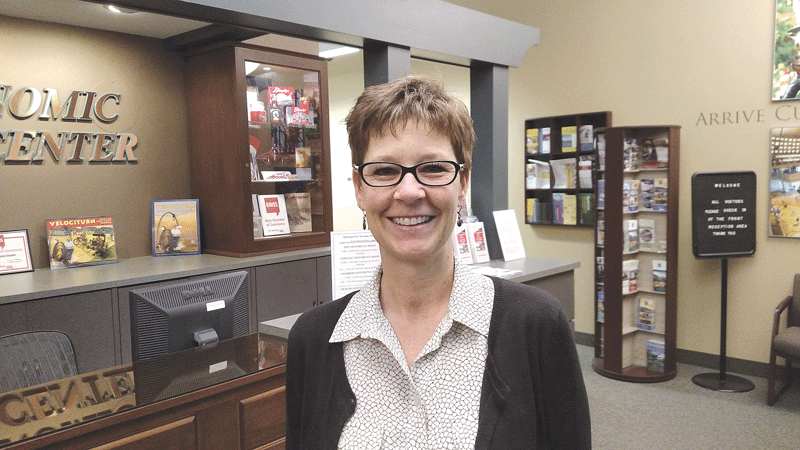
Economic Outlook 2017
Balance Statement
Forecast Is Strong for 2017, but Questions Loom on the Horizon
 After six years of largely uninterrupted economic growth in both Massachusetts and the U.S. as a whole, questions have arisen as to how long the expansion can last, especially coming on the heels of an unusual election season and amid sluggish economic trends internationally. The consensus seems to be that the present course should hold in 2017, but also that recessions are a regular occurrence in the American economy, and it wouldn’t take much to spark a slowdown. For now, though, cautious optimism reigns.
After six years of largely uninterrupted economic growth in both Massachusetts and the U.S. as a whole, questions have arisen as to how long the expansion can last, especially coming on the heels of an unusual election season and amid sluggish economic trends internationally. The consensus seems to be that the present course should hold in 2017, but also that recessions are a regular occurrence in the American economy, and it wouldn’t take much to spark a slowdown. For now, though, cautious optimism reigns.
Rarely, economists note, does the U.S. economy grow for a full decade without hitting a recession. So the continuing strength of the economy — reflected most notably in falling unemployment — is a mixed bag of news. In short, while the growth is welcome, some caution is warranted.
“At the state and national level, the recovery has been going on for six years, and while there are no hard-and-fast rules about this, we could expect some moderation after six years of growth,” said Karl Petrick, assistant professor of Economics at Western New England University. “Every year of growth makes it more likely that the downward part of the business cycle is closer.”

Karl Petrick
Because of both economic and political reasons, I think the state economy is entering into a period of more uncertainty. Luckily, we are doing so after a period of robust economic growth, so, as a state, we have a good foundation to weather this uncertainty.”
A year ago, Bob Nakosteen, professor of Economics at the Isenberg School of Management at UMass Amherst, called the economic outlook “fuzzy,” but said last week that 2016 solidified into a positive year on many fronts.
“Growth statewide has been somewhat modest, but continuous; we haven’t seen the unemployment rate this low since 16 years ago, the turn of the century,” said Nakosteen, who is also co-editor of MassBenchmarks, the quarterly publication devoted to analysis of the Bay State’s economy. “I don’t think the economy is going gangbusters, but it’s been steady, moderate growth over a long period of time, with higher employment numbers and the total number of workers higher.”
Slowly and steadily, if not spectacularly, he went on, the economic outlook since the low point of the Great Recession has morphed into a remarkable period of expansion. In Massachusetts, the main drivers include the usual suspects, such as information and communications technology, healthcare, and education. “These are industry sectors that are in high demand both nationally and globally, and we have the good luck, at least in the recent past, to have a heavy dose of those sectors. Any time there’s a big demand in the national economy for the services and industries we specialize in, it’s going to help us, and that’s what’s happening.”

PeoplesBank’s Tom Senecal (left) and Mike Oleksak say indicators like rising employment and fewer foreclosures point to a strengthening economy.
Massachusetts, Petrick noted, has outpaced the national rate of growth since 2008. For example, the state’s economy expanded at an annual rate of 3.7% in the third quarter of this year, while the national annualized rate of growth was 2.9% during that same period.
A similar trend holds in the category of unemployment rate. In October 2016, the last month for which state data is available, the Bay State’s unemployment rate was 2.7%, compared to the U.S. unemployment rate of 4.9%.
But is unemployment falling because more people are finding jobs, he asked, or because people are leaving the labor force and aren’t being counted? Comparing October 2016 to Oct 2015, the labor force grew while the unemployment rate fell (from 4.5% in Oct 2015 to 2.7% in Oct. 2016). While that’s a sign of success, one result is a tightening job market.
“The unemployment rate is falling for the right reasons, but it does also signal that it will be harder to keep up the pace of economic growth that we have been experiencing as the labor market gets tighter,” he told BusinessWest. “Effectively, it will be harder for those who are unemployed to find work.”
Meanwhile, the 2.7% number doesn’t tell the whole story. The official (U3) unemployment rate, the one that gets reported, counts anyone who is either working or willing to work, defined as someone who has looked for a job in the past four weeks, he explained. A broader measure of unemployment is the U6 rate, which includes workers who have given up looking for work but would return to the labor force if jobs were available, as well as people who are employed part-time because they can’t find a full-time job. The average U6 number in Massachusetts is 8.8%.
“The difference between that and the state U-3 rate does indicate that there is potentially more room to grow in Massachuetts,” Petrick said. “That’s a lot of potential workers that are on the sidelines who could return to the labor market if things continue to improve.”
Whether the economy will, indeed, continue to improve is the big question.
East and West
Petrick and Nakosteen both noted that breaking the state down by region results in a much more mixed picture for Western Mass.
Specifically, while Hampden County’s U3 rate fell from 6.0% to 3.6% from October 2015 to October 2016 — and similarly decreased from 8.3% to 5.1% in Springfield and 7.4% to 4.3% in Holyoke — those figures trail other metro areas in Massachusetts, including Boston (2.6% in October 2016) and Worcester (3.3%). In fact, Springfield’s 5.1% rate ranks among the highest city unemployment rates in the state.
“The recovery started sooner in Eastern Mass., and it took a while for the effects to be really felt in the western part of the state,” Petrick said. “Over the past year, we have seen a degree of catching up … after lagging in Western Mass. for a few years, the rate of job growth is now pretty consistent across the state.”
One interesting result over the past year, he noted, has been a rebound in the construction industry in Massachusetts, which saw employment grow by almost 38%. But much of that growth — particularly new construction — has been concentrated in the Greater Boston area. Still, he went on, as construction was hard-hit by the recession, a rebound in this sector is a positive sign.
Bob Nakosteen
I don’t think the economy is going gangbusters, but it’s been steady, moderate growth over a long period of time, with higher employment numbers and the total number of workers higher.”
“It’s always been the case that the growth in Boston spreads very unevenly, and it dissipates as it gets farther from Boston,” Nakosteen added. “In Western Massachusetts, our employment numbers have increased, but not dramatically.”
One oft-discussed reason has been the decline of the manufacturing base over the past few decades, with no one industry stepping up to replace it. “We have a smattering of everything, and a number of manufacturing companies, but nothing very big.”
Area economic-development leaders hope the emergence of CRRC USA Rail Corp., a subsidiary of the China-based world leader in rail-car manufacturing — which promises to create more than 150 manufacturing jobs in Springfield when its plant on Page Boulevard opens in 2018 — is a harbinger of more good news for the region’s manufacturing sector. At the same time, downtown projects like Union Station and MGM Springfield, coupled with a surge in entrepreneurial activity in the region, bode well for the future.
So do the continued health of the ‘eds and meds’ sectors in the region. Nakosteen noted that people think of Massachusetts’ world-class hospitals when they think of the state’s healthcare prowess, but in addition to that anchor, companies that perform pharmaceutical research and build medical devices are thriving — although, again, mainly in the eastern part of the state.
Still, he went on, “there has been some convergence of the economic prospects of the eastern and western parts of the state, and that’s a good thing.”
Nancy Creed, president of the Springfield Regional Chamber, said her organization’s members are mainly bullish on the year ahead.
“There’s a lot of optimism. I hear it on the streets and in chamber meetings,” she said. “We’re seeing new business come into the city — small businesses, especially, that want to be part of what’s happening here. And the chamber is growing — chamber members are increasing job growth, increasing spending. I think, overall, people are feeling good about the city of Springfield.”

Nancy Creed says businesses expect to grow in 2017, despite caution over what national events and trends represent.
However, “I would say it’s also tempered with what could potentially happen with the new federal administration,” she added. “Who knows what’s going to happen with healthcare and the ACA? So there’s also some caution overall.”
Indeed, Petrick noted, markets don’t like uncertainty, and they tend to be volatile during an election year in the U.S. — particularly one as unpredictable and unusual as the one that gave rise to President-elect Donald Trump and his aggressive rhetoric regarding trade.
“Certainly two of our biggest trade partners at the national level, China and Mexico, have both responded by letting us know that a trade war is a very bad idea for the U.S. as well as for them,” he said. “They have also both let the incoming administration know that there’s not a whole lot of good will there after a series of inflammatory statements regarding both countries during the campaign.
Those relationships need mending, he said, and it’s in the interest of both the U.S. and Massachusetts economies for that to happen. At the national level, he noted, much uncertainty lingers — more than what is typical after an election — and both companies and consumers want to see what the incoming administration will do, particularly after so many statements, many of them contradictory, regarding potential policy.
“So, because of both economic and political reasons, I think the state economy is entering into a period of more uncertainty,” Petrick said. “Luckily, we are doing so after a period of robust economic growth, so, as a state, we have a good foundation to weather this uncertainty.”
In the financial world, indicators reflect general economic health, said Thomas Senecal, president and CEO of PeoplesBank.
List of Business and Economic Development Resources
“Interest rates, obviously, drive most of what we do,” he said, adding that the Fed is expected to raise rates another 25 basis points this week, and he anticipates further jumps in the spring and perhaps the fourth quarter of 2017. “We see it as a moderate increase in rates that won’t have a huge, detrimental effect.”
In fact, he added, the Fed moves should instead translate into positive consumer confidence, which usually brings positive economic impact.
Meanwhile, Senecal added, “unemployment is significantly down in Western Mass., and we see in the banking industry that foreclosures are down, delinquencies are down — these are all positive signs for the economy.”
Broader Trends
Other fundamentals at the national level remain positive, Petrick said. The International Monetary Fund (IMF) estimates that the U.S. economy will grow by 2.2% over the next year. That’s a strong rate of growth, although one part of the IMF forecast — higher energy prices — is better for some states (like Texas and North Dakota) than for Massachusetts. The IMF also estimate that the U.S. dollar will weaken over the coming year, which is good news for exports from Massachusetts, as a strong dollar over the past two years has seen state exports to many top trade partners suffer.
While the national economy is still growing, Nakosteen noted, it’s growing at a slightly slower rate than in previous years, and that’s bound to affect Massachusetts. “We can only be healthy to the extent of a strong national economy.”
Meanwhile, globally, China continues its transformation from an export-led economy to one more consumer-driven, and that could be a painful process. “It’s not clear that transition will be successful or happen any time soon,” he said, “and it’s not clear the politics in that country will be able to sustain it.”
As for Europe, “what they consider good news, we’d call stagnant. We’d be lamenting it here, but they’re happy there. There’s not much in the tea leaves to say that will change any time soon,” Nakosteen said, adding that slowdowns in commodities exports — a problem from Asia to Africa to Canada — are proving to impact economies negatively as well.
“The world isn’t on the brink of anything, but it’s certainly challenged in a number of ways, and certainly just slogging along,” he said. “We’re not disconnected from any of that. Even though we have a really dynamic economy, these trends are bound to suppress growth at some point. We’ve managed to keep modest growth continually for a long time, but there are troubling outside signs.”
Petrick agreed. “A generally sluggish world economy doesn’t help the U.S. or the Massachusetts state economy. The weakened Chinese economy, a sluggish European Union, and the continued fallout from the Brexit vote in the UK all bear watching.”
Michael Oleksak, executive vice president, senior lender, and chief credit officer at PeoplesBank, noted, as many analysts have, that Western Mass. is to some degree more shielded from national trends than, say Boston — never reaching the same heights or plumbing the same depths.
“The last few years, we’ve seen positive trends for both our customers and prospective customers,” he said, adding that he sees some staying power in regional trends like rising household incomes, strong commercial occupancy levels, and an uptick in home purchases in the mortgage realm after several years of refinances dominating that sector. Meanwhile, he sees the casino and other large projects causing a trickle-down effect of renewed investment interest in the region.
“I think the casino and CRRC will have an impact on the Western Mass. market; there will be some economic spilloff from that,” Senecal added. “Any time you see cranes in the sky, it makes you feel good about what’s going on in the immediate area.”
Meanwhile, some sectors are dealing with trends that are more cultural than economic, notably retail, which continue to grapple with Internet sales cutting deeply into their bottom line. Nakosteen said he has talked to store owners who say they hear that things are getting better, but they’re not seeing it themselves. “Retailers across the state and nation are struggling to deal with the Internet world.”
Bottom Line
In summary, Petrick expects Massachusetts’ economic growth to remain positive in 2017 but at a slower rate, closer to the U.S. national rate of growth.
“It’s really hard to continually outpace the national rate of growth after so many years of doing so,” he said. “I suspect, for at least part of the year, we will grow faster than the national average, but the gap will get narrower.”
One advantage the Bay State has is a high percentage of educational attainment, as 41.5% of residents in age 25 or older have a bachelor’s degree or higher; the national rate is 30.6%. “That is one of the reasons that Massachusetts is an attractive place for companies to locate.”
On the other hand, they still grapple with skills gaps, trying to match their needs with the available talent. But one of the more positive stories over the past decade in Western Mass. has been the region’s efforts to attack that problem.
“The skills gap is always going to be a concern, as businesses evolve and have different needs,” Creed said, adding, however, that the city has been fortunate to see robust partnerships emerge between its colleges, technical schools, and workforce-development agencies to prime the pump of talent and keep it in the region. “That’s the nature of the beast — businesses evolve, the skills they need evolve, and we’ve got to keep pace with that.”
Those partnerships don’t happen everywhere and shouldn’t be taken for granted, she added — but they are being noticed by both local companies and those looking for a place to plant new roots.
“I hear it from people at my events — they want to be downtown, they want to be part of the excitement. They want to be part of what’s happening here.”
It’s an optimism being felt across Western Mass. — admittedly, more strongly in some communities than others — as the calendar turns to 2017, and all the economic questions a new year brings.
Joseph Bednar can be reached at [email protected]






